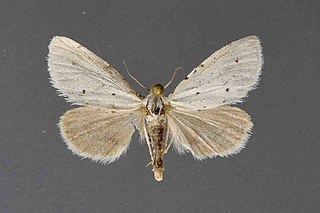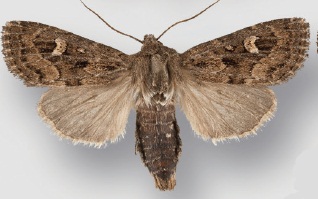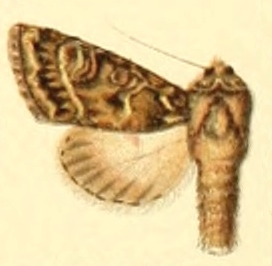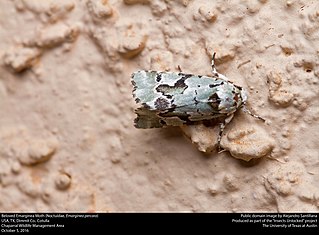
Xestia is a genus of noctuid moths. They are the type genus of the tribe Xestiini in subfamily Noctuinae, though some authors merge this tribe with the Noctuini. Species in this genus are commonly known as "clays", "darts" or "rustics", but such names are commonplace among Noctuidae. Xestia moths have a wide distribution, though they most prominently occur in the Holarctic.
Afotella is a monotypic moth genus of the family Noctuidae erected by William Barnes and Foster Hendrickson Benjamin in 1926. Its only species, Afotella cylindrica, was first described by Augustus Radcliffe Grote in 1880. It is found in western North America from Saskatchewan and Alberta south to California.
Engelhardtia ursina is the only species in the monotypic moth genus Engelhardtia of the family Noctuidae. The genus was erected by William Barnes and Foster Hendrickson Benjamin in 1923 and the species was first described by John B. Smith in 1898. It is known from the US state of Colorado.
Eviridemas is a monotypic moth genus of the family Noctuidae erected by William Barnes and Foster Hendrickson Benjamin in 1929. Its only species, Eviridemas minuta, was first described by Barnes and James Halliday McDunnough in 1910.

Grotellaforma is a monotypic moth genus of the family Noctuidae erected by William Barnes and Foster Hendrickson Benjamin in 1922. Its only species, Grotellaforma lactea, was first described by Stretch in 1885. It is found in North America, including California and Arizona, its type locations.
Hemioslaria is a monotypic moth genus of the family Noctuidae. Its only species, Hemioslaria pima, is known from the US state of Arizona. Both the genus and species were first described by William Barnes and Foster Hendrickson Benjamin in 1924.
Lemmeria is a monotypic moth genus of the family Noctuidae erected by William Barnes and Foster Hendrickson Benjamin in 1926. Its only species, Lemmeria digitalis, was first described by Augustus Radcliffe Grote in 1882. It is found in the US state of Maine.

Lithophane is a genus of moths of the family Noctuidae. They spend the winter as adults.
Neotarache is a monotypic moth genus of the family Noctuidae. Its only species, Neotarache deserticola, is found in the US state of Nevada. Both the genus and species were first described by William Barnes and Foster Hendrickson Benjamin in 1922.
Properigea is a genus of moths of the family Noctuidae. The genus was erected by William Barnes and Foster Hendrickson Benjamin in 1926.

Resapamea is a genus of moths of the family Noctuidae.

Scotogramma is a genus of moths of the family Noctuidae.
Sexserrata is a monotypic moth genus of the family Noctuidae. Its only species, Sexserrata hampsoni, is found in the US state of California. Both the genus and species were first described by William Barnes and Foster Hendrickson Benjamin in 1922.

Grotella harveyi is a species of moth in the genus Grotella, of the family Noctuidae. This moth species is found in North America, including Colorado, its type location.

Grotella stretchi is a species of moth in the genus Grotella, of the family Noctuidae. This moth species was first described by William Barnes and Foster Hendrickson Benjamin in 1922. It is found in North America, including California, its type location.

Euparthenos is a monotypic moth genus in the family Erebidae erected by Augustus Radcliffe Grote in 1876. Its only species, Euparthenos nubilis, the locust underwing, was first described by Jacob Hübner in 1823. The adults resemble some of the underwing moths of genus Catocala, which are fairly close relatives, in color, pattern, and the habit of resting on tree trunks. But E. nubilis can usually be immediately recognized by the four concentric black bands per hindwing, as opposed to one or two in Catocala. Color morphs of E. nubilis with altered pattern are known, however, and these may be hard to recognize without detailed examination.

Lasionycta poca is a moth of the family Noctuidae first described by William Barnes and Foster Hendrickson Benjamin in 1923. It is found throughout the Rocky Mountains of Alberta, westward to the Coast Range in western British Columbia and southward in the Cascades to Okanogan County, Washington.

Psammopolia is a genus of moths of the family Noctuidae.

Psammopolia wyatti is a moth of the family Noctuidae first described by William Barnes and Foster Hendrickson Benjamin in 1926. It occurs in western North America from southern Oregon to the Queen Charlotte Islands of British Columbia. The moth has been included in both 1983 and 2010 MONA indices.

Psaphidini is a tribe of owlet moths in the family Noctuidae. There are at least 40 genera and at least 90 described species in Psaphidini.








